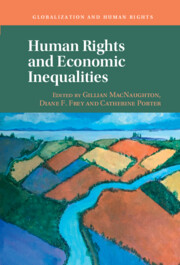Book contents
- Human Rights and Economic Inequalities
- Reviews
- Globalization and Human Rights
- Human Rights and Economic Inequalities
- Copyright page
- Dedication
- Contents
- Figures
- Tables
- Boxes
- Notes on Contributors
- Acknowledgments
- 1 Introduction
- Part I Conceptualizing and Measuring Human Rights and Economic Inequalities
- Part II Causes and Consequences of Economic Inequalities
- 6 A Framework for Fiscal Justice: How Human Rights Can Change Public Finance
- 7 Global Tax Justice and Human Rights
- 8 Growing Inequality and Risks to Social Rights in Our New Data Economy
- 9 Caste, Economic Inequality, and Climate Justice in India
- Part III Socioeconomic Rights and Economic Inequalities
- Index
- References
9 - Caste, Economic Inequality, and Climate Justice in India
from Part II - Causes and Consequences of Economic Inequalities
Published online by Cambridge University Press: 29 September 2021
- Human Rights and Economic Inequalities
- Reviews
- Globalization and Human Rights
- Human Rights and Economic Inequalities
- Copyright page
- Dedication
- Contents
- Figures
- Tables
- Boxes
- Notes on Contributors
- Acknowledgments
- 1 Introduction
- Part I Conceptualizing and Measuring Human Rights and Economic Inequalities
- Part II Causes and Consequences of Economic Inequalities
- 6 A Framework for Fiscal Justice: How Human Rights Can Change Public Finance
- 7 Global Tax Justice and Human Rights
- 8 Growing Inequality and Risks to Social Rights in Our New Data Economy
- 9 Caste, Economic Inequality, and Climate Justice in India
- Part III Socioeconomic Rights and Economic Inequalities
- Index
- References
Summary
Inequalities exist in various forms in all sectors of our lives, including social, political, economic, gender, racial, caste, language, ability, religion and region. All of them are carefully constructed and systemically practiced through culturally crafted structures of oppression. In neoliberal markets, economic inequalities affect vulnerable communities adversely to the extent of immovable cyclical economic conditions. Economic inequalities are linked to unequal distribution of wealth, income, and pay, but, these variables are not absolute.
- Type
- Chapter
- Information
- Human Rights and Economic Inequalities , pp. 217 - 244Publisher: Cambridge University PressPrint publication year: 2021



